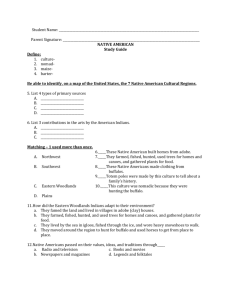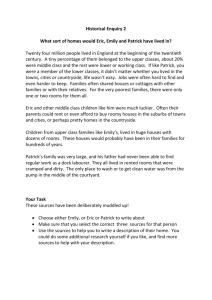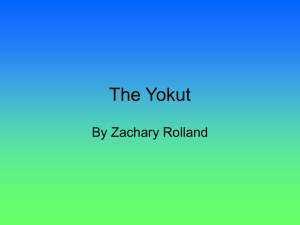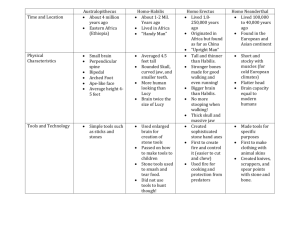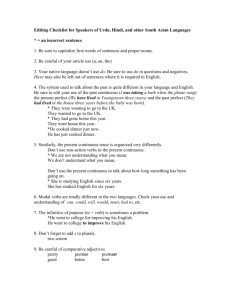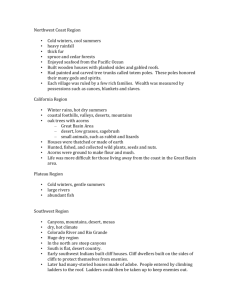Chapter 2 Notes - Mahopac Central School District
advertisement
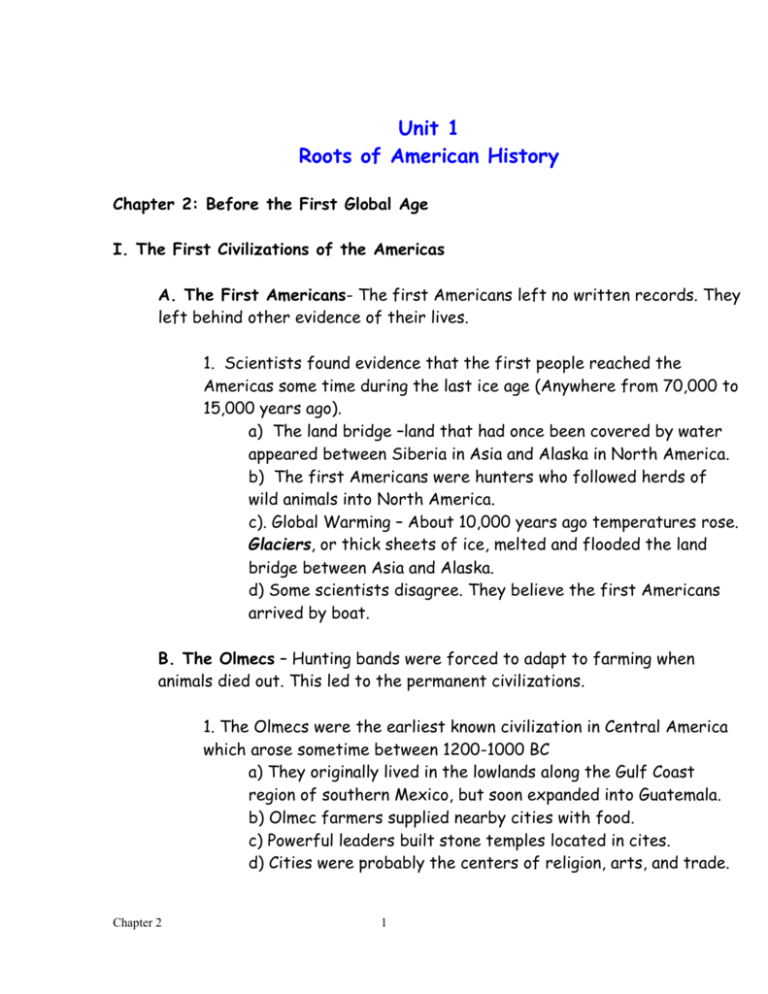
Unit 1 Roots of American History Chapter 2: Before the First Global Age I. The First Civilizations of the Americas A. The First Americans- The first Americans left no written records. They left behind other evidence of their lives. 1. Scientists found evidence that the first people reached the Americas some time during the last ice age (Anywhere from 70,000 to 15,000 years ago). a) The land bridge –land that had once been covered by water appeared between Siberia in Asia and Alaska in North America. b) The first Americans were hunters who followed herds of wild animals into North America. c). Global Warming – About 10,000 years ago temperatures rose. Glaciers, or thick sheets of ice, melted and flooded the land bridge between Asia and Alaska. d) Some scientists disagree. They believe the first Americans arrived by boat. B. The Olmecs – Hunting bands were forced to adapt to farming when animals died out. This led to the permanent civilizations. 1. The Olmecs were the earliest known civilization in Central America which arose sometime between 1200-1000 BC a) They originally lived in the lowlands along the Gulf Coast region of southern Mexico, but soon expanded into Guatemala. b) Olmec farmers supplied nearby cities with food. c) Powerful leaders built stone temples located in cites. d) Cities were probably the centers of religion, arts, and trade. Chapter 2 1 2. Olmec Achievements a) Scientists have found huge stone heads – may have represented kings. b) They left few written records c) They used the stars to develop a calendar so they could predict the change of seasons. 3. Around 300 BC, the Olmec vanished for reasons that vanished with them. We do know, however, that much of their culture and social structure was absorbed by other peoples. The Olmecs, as far as we can tell, are the first chain in the development of Mesoamerican culture. C. The Mayas 1. Mayan civilization emerged about 3,000 years ago. a) Location- rainforests in present day southern Mexico. b) Most were farmers – they dug canals to drain swampy land. c) Most lived outside of the cities in houses with thatched roofs and mud walls. 2. Mayan Cities a) Built large cities (ex. Tikal)- each city had its own ruler. b) Built huge stone pyramids- the tops of the pyramids had temples where priests performed elaborate ceremonies. (animal and human sacrifices) c) People were divided into social classes: Priests, nobles, peasants, farmers, and slaves. 3. Mayan Achievements a) Priests created an accurate 365 day calendar. b) Developed an advanced number system that included the concept of zero. c) Hieroglyphics- a writing system that uses pictures to represent words or ideas. Chapter 2 2 4. Around 850 AD the Mayas abandoned their cities. Historians and archaeologists are not sure why. a) peasants rebelled b) soil wore out c) wars between cities D. The Aztecs 1. A powerful empire located north of the Maya. a) Built their capital city- Tenochtitlan-on and island in the middle of a lake. b) Built roads to connect to the mainland. c) Farmers dug canals for irrigation. d) planted crops on floating gardens - chinampas e) conquered neighboring peoples. f) Also divided into social classes 2. Religion was central to Aztec life. Priests developed 18 month calendar. a) Each month was governed by its own God. b) Made human sacrifices to the Sun God. c) Also used hieroglyphics. 3. The Emperor had absolute power. a) By the 1500’s the Aztecs ruled millions of people. b) Heavy taxes and a demand for human sacrifices led to revolts. c) The emperor had a powerful army. E. The Incas 1. The Incas united the largest empire in the Americas. a) Stretched for 3,000 miles along the coast of South America. b) Capital city- Cuzco-located high in the Andes Mountains. Chapter 2 3 2. Expert farmers a) Carved terraces into mountainsides and built stone walls to keep rains from washing soil off the terraces. b) The emperor, known as Sapa Inca, controlled all of the land and riches of the empire. c) Officials kept records of what each family produced. 3. Expert engineers. a) Built huge stone temples. b) Built a complex network of roads (more than 19,000 miles). They carved through rock and built rope bridges. c) Teams of runners carried news quickly across the empire. 4. Achievements in Medicine. a) Used quinine to treat Malaria. b) Performed successful brain surgery. c) Discovered medicines to lessen pain. 5. Religion a) Worshiped the sun. b) Lined the walls of palaces and temples with sheets of gold to honor the sun. c) Made animal and human sacrifices. 6. In the 1520’s a civil war broke out that weakened the empire. F. Early Cultures of North America 1. The Hohokams lived in southern Arizona about 2000 years ago. a) They were farmer who raised corn, beans, and squash. b) They used irrigation to farm desert lands. Chapter 2 4 2. The Anasazi (also known as cliff dwellers) lived between 750 and 1300. a) They were also farmers who used irrigation. b) They built large multistoried houses out of Adobe, or sun dried brick. c) These houses made up pueblos, or villages. d) They created a network of roads linking dozens of towns. e) In the late 1200’s a drought, or long dry spell, led to the abandonment of these villages. 3. The Mound Builders a) Belonged to various groups. b) The first mounds were burial grounds, other were platform mounds. c) Some mounds were animal shaped. d) They lived from eastern Oklahoma to the Atlantic Ocean. e) The Mississippians built the Great Cahokia Mound in Illinois (116 acres) between 900 –1250 A.D. Chapter 2 5 II. The Peoples of North America A. Culture Areas and Tribes. 1. There were 10 major culture areas of North America, north of Mexico. a) A culture area is a region in which people share a similar way of life. b) Within each culture area, there were many different tribes. B. Culture Areas 1. Arctic- frozen seas and icy treeless plains. a) Inuits- people of the artic. b) In the winter they built igloos, or houses of snow and ice. c) In warmer months they lived in pit houses, houses dug in the ground and covered with wood and skin. d) In the winter and spring they hunted seal. In the summer they moved inland to hunt caribou or fish in rivers and lakes. e) They used Kayaks, or small skin boats. 2. Sub-arctic- They too moved from place to place hunting caribou and moose. a) They made clothing from rabbit skins and caribou, which they could trade with the Europeans. 3. Northwest Coast- People of this area had a favorable climate and a large food supply. a) Kwakiutls- people of this area who fished. b) Built houses and canoes from wood. c) Built permanent villages. d) Potlatch – dinner to show off wealth. e) Totem poles – tells visitors of the great deeds of the family. Chapter 2 6 4. The Great Basin- lies in the dry inter mountain region of the U.S. With little water few plants and animals survive. As a result, people spent most of their time hunting rabbits, or digging up roots. a) Utes and Shoshones - built shelters out of willow poles and reeds. b) They moved around. Families spent most of their time looking for food. 5. Plateau-The peoples of the plateau lived between the Rocky Mountains and the Cascades. They fished, hunted and gathered their food. a) Nez Perces 6. California-Had diverse cultures. Coastal peoples fished, while those who lived in the Northern Valleys hunted. a) Pomos 7. Southwest- The Pueblos were descended from the Anasazi. They lived in adobe houses. Most Pueblo villages had a kiva, or underground chamber where men held religious ceremonies. The pueblos traced their family line through the mother. Women owned most of the family property. Other tribes included: a) Hopis b) Zunis c) Acomas d) Lagunas About 1500 2 new groups arrived: e) Navajos- they lived in Hogans, houses made of mud and wooden poles. f) Apache 8. Great Plains- The people of the Great Plains farmed and hunted. They lived in tepees. a) Blackfeet b) They hunted buffalo, and used it for food, clothing, and shelter. Chapter 2 7 9. Southeast- The southeast was home to more Native Americans than any other region. A warm climate enabled them to produce good crops. They built houses out of saplings, or young trees. a) Natchez 10. Eastern Woodlands- The people of the Woodlands hunted for food and were farmers. a) Iroquois- They lived in present day New York State. They built long houses. The Women owned all of the property and chose the sachems, as the tribal chiefs were called. The Iroquois had 5 Nations that fought constantly. With the help of Dekanawida and Hiawatha the league of the Iroquois was formed. 1) Mohawk 2) Seneca 3) Onondaga 4) Oneida 5) Cayuga Chapter 2 8 III. Tradition and Change in Europe A. The Vikings – The first Europeans to reach North America. 1. The Vikings were fierce seagoing people from Scandinavia. a) They first settled in Iceland. b) Eric the Red – sailed west. He settled Greenland. c) His son Leif – sailed further west. Called the land Vinland (1001). d) Archaeologists think Vinland was the northern most tip of Newfoundland. e) About 1013 the Vikings left Vinland. No one is sure why. B. Europe in the Middle Ages (500-1350) 1. The Middle Ages-European kings and queens divided their lands among powerful nobles. Under this system, there were few merchants or traders. Few roads or towns existed. As a result, there was very little contact between people from different regions. a) Feudalism – system of rule by lords who owe loyalty to a king. b) Manor – included the lord’s castle, peasant’s huts, and surrounding villages or fields. They were self-sufficient. c) Serfs – peasants bound to the land for life. 2. Effects of the Crusades –From about 1100 to 1300, the Roman Catholic Church fought a series of religious wars to gain control of the Holy Land from the Turkish Muslims. a) For the first time people traveled beyond their small towns. b) They encountered new foods, products, and ideas. c) Arabs taught Italians how to use new instruments to navigate large bodies of water. Chapter 2 9 1. Magnetic Compass –Showed which direction was north. 2. Astrolabe- measured the positions of the stars to determine latitude at sea. 3. Marco Polo returns from China a) He had spent 24 years there. b) He wrote a book describing the great riches and wonders of China. It increased the desire for goods from Asia. c) Silk Road- Muslim traders traveled overland routes to reach China. These overland routes became known as the Silk Road because prized Chinese silks had been carried over them for more than 2,000 years. 4. Chinese voyages of trade and exploration – The young emperor, Zheng He, came to power in 1402 and built a huge fleet that had more than 300 ships. For 28 years his fleet traded tons of goods in Southeast Asia, India, Arabia, and East Africa. a) There was a great demand for Chinese goods such as silks and spices. b) When Zheng He died, the new emperor decided the Chinese had nothing to learn from the outside world, and outlawed foreign travel. c) Still, Chinese products were in demand. Other countries would try to find sea routes to Asia. C. The Renaissance (1350 –1500) 1. The Renaissance Spirit – Increased trade and travel made Europeans curious about the wider world. This resulted in many discoveries. a) Scholars studied the works of ancient roman and Greeks. b) New discoveries were made c) The Printing Press- developed in the mid 1400s by Johannes Gutenberg – this helped the spread of knowledge. Chapter 2 10 D. Rise of Strong Nations 1. During the Renaissance strong rulers gained control over feudal lords forming the nations we know today. a) England and France – rulers increased their power when many feudal lords slaughtered each other in a long series of wars. b) In Spain and Portugal Christian knights fought to push the Muslims out. c) 1469 –Ferdinand, king of Aragon and Isabella, queen of Castile married and united much of Spain. 2. European Nations Seek Trade – New rulers of England France, Portugal, and Spain all looked for ways to increase their wealth. a) They wanted to trade with China and other lands in Asia. b) Italians and Arabs controlled trade routes across the Mediterranean Sea. c) European rulers needed to find another route to Asia. Chapter 2 11 IV. Search for New Routes to Asia A. Portugal Takes the Lead 1. Like other nations Portugal was eager to expand its trade. Using a new type of ship, the caravel, they sailed farther and farther south. a) Prince Henry the Navigator – He wanted to improve navigation, or the practice of plotting a course at sea. b) 1418 – he set up a school for sailors. d) He invited mapmakers and astronomers to draw up new maps to be used at sea. e) He sent ships to explore the west coast of Africa. B. African Trading States- In the 1400s, Europeans knew little about Africa. 1. Portuguese explorers traded with Africans along the east and west coasts of Africa. a) Africans exchanged gold, ivory, and statues of polished teakwood for European weapons and other goods. b) Gold Coast – part of the coast of West Africa. 2. City-States of East Africa- trade flourished up and down the coast. a) Wealth from trade helped build powerful city-states, large towns that had their own governments and control of the surrounding countryside. 3. Trading Kingdoms of West Africa – The best known were Mali and Songhai. a) The city of Timbuktu was a major trading center for both kingdoms. b) Mali’s ruler, Mansa Musa, was a Muslim who made a pilgrimage to Mecca in the Middle East. During his journey people were dazzled by his gold and riches. c) Europeans began to look at Africa as a source for riches. Chapter 2 12 4. The Portuguese Slave Trade – In 1441, they raided an African village and captured 12 people. These Africans were sold as slaves in Europe. a) By 1460, about a 1,000 Africans were sold each year in Portugal. C. Around Africa to India 1. Portugal looks beyond Africa to India a) 1497 – King John sent off four ships to India b) Vasco da Gama –by 1498 he passed the southern tip of Africa and continued north and east to India. c) Cape of Good Hope- the Southern tip of Africa. d) From India they sailed onto the East Indies. e) They built a rich trading empire in Asia. Chapter 2 13 Chapter 2 14
